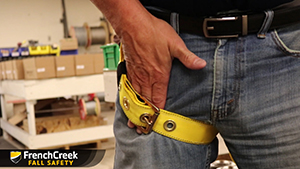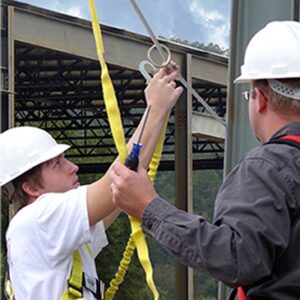Your cart is currently empty!
FIVE MOST COMMON FALL PROTECTION MISTAKES
In the fall protection industry, every decision can be the difference between serious injury or worse… Here are the Five Most Common Fall Protection Mistakes and how to avoid them.
1. Harnesses do not fit properly
Today’s full-body harnesses can be equipped with the necessary gear and options to meet the demands of any job. Whether you work in the construction, wind energy, ironwork, or telecom industries these harnesses help workers get the job done as safely and efficiently as possible.
Should a fall occur, fall arrest forces are distributed evenly throughout the body, substantially reducing the chances of injury. However, fall protection harnesses are not foolproof. Faulty or misused fall protection can be just as dangerous as using no fall protection at all.
Knowing how to properly don and adjust a fall protection harness can save your life. Before wearing a harness it is imperative to inspect it for any damage including worn, frayed, or missing threads, cracked webbing, or foreign material on the harness.
If any damage is visible immediately remove it from service.
Harnesses come in several styles and configurations, please refer to the manufacturer’s instructions on donning procedures for your specific harness.

To don a typical vest style harness:
- Grasp the harness by the back D-ring and shake it to allow the straps to fall into position.
- Make sure all buckles are unbuckled and place the harness over your shoulders like a jacket
- Connect the waist belt (if equipped)
- Connect the leg straps. The legs straps should be adjusted tightly so you can slip two fingers between the webbing and your legs. If your entire hand fits the strap needs to be adjusted.
- Adjust the shoulder straps
- Connect and adjust the chest strap
- Adjust all buckles until equally snug, and a comfortable fit is achieved.
2. Misuse of Leading Edge SRL’s
A leading-edge SRL is a self-retracting lifeline manufactured to meet the ANSI Z359.14 standard. This standard calls for specific accommodations for leading-edge applications and foot-level fall events. To prevent the unit from shearing on a sharp edge, Leading edge SRL’s are made out of strong cable constituent and includes an energy-absorbing shock pack to dissipate fall arrest forces.
Often, normal self-retracting lifelines are used in leading-edge applications and are seriously jeopardizing the safety of workers at height.
Always consider the following when it comes to leading-edge applications:
- Ensure that your equipment (SRL) is rated for leading-edge applications. This includes ensuring that there is an energy absorber at the worker’s body to minimize fall arrest forces on the body. Refer to the manufacturer’s instructions on how to properly use a leading-edge SRL.
- Consider other alternatives when working near leading-edge applications. Many times, the danger of working with the risk of a leading-edge hazard can be completely eliminated by not allowing your workers to get to the hazard. Many times, this can be done simply by placing your workers in restraint with a simple rope and rope grab. Used properly, this will allow workers to continue work to the edge but physically restrains them from taking a fall over the edge. With all of the latest and greatest products in the fall protection industry, it may come as a surprise that sometimes the safest solutions are the simplest.
- Ensure that all workers have the proper training and understanding of leading-edge hazards and the limitations of their mechanical equipment.
It is wise to have a competent person perform a safety assessment before any work begins on the job site.
3. Lack of Training
Fall protection training is a requirement by OSHA designed to keep all workers safe. Making sure your employees have hands-on training before performing a job ensures that they not only know what equipment to use but how to use it as well. Falls from height are the number one cause of death in the construction industry. OSHA cites fall protection as the number one most frequently violated citation.
It does not matter if a worker is going to be working at height for a few seconds or minutes – a fall can occur instantly and with little to no warning. Training employees on the proper use of the equipment and how to avoid falls allows them to be informed, prepared, and more likely to comply with safety rules while working at height.
The training that takes place, whether on the job site or in a facility with a trainer, needs to be more than just watching videos and signing off on a roster. That’s why at FrenchCreek, we offer multiple training programs with varying lengths of time. Whether we come to your site or you come to our headquarters, our certified and experienced trainers will ensure you leave the training program confident in your ability to stay safe.
If you want to know more about our training programs, please visit our Training Page or contact us today at 877.228.9327
4. No Rescue Plan
Simply put, a rescue plan is the implementation, practice, and knowledge on how to safely rescue a worker whether that be in a confined space, from a free fall, or from any dangerous situation. Creating and having all persons on a job site know a rescue plan can be the difference between life and death. Preparing a rescue plan for every job site is crucial to keeping workers safe on the job. Creating a rescue plan, and knowing what it is, for each specific job site may seem tedious, but will save precious minutes from being wasted if a worker needs to be rescued.
Why can’t I just have one rescue plan and use it for all job sites? You can’t do the same exact things for each job you complete, right? This is no different for a rescue plan. While much of your rescue plan can reasonably stay the same, there are key areas that will have to change from job site to job site.
1. Location of Equipment
Where you store your rescue equipment, such as ladders, rescue poles, raising/lowering devices, and rescue rope will obviously change with each job site. Specifically, you should write down the exact location of your equipment used in a rescue (inside Work Trailer A, left-hand side) so you do not waste precious moments looking for equipment.
Obstructions/Hazards/Landing Area: No two job sites will have the same exact obstructions, hazards, or landing area. Your rescue plan should reflect this.
Download our FREE rescue plan PDF to fill out for your own personal needs.
5. Failure to inspect equipment.
Failing to inspect your equipment before every use is a serious and sometimes deadly fall protection mistake. Not only should your equipment be inspected before every use but it needs to inspect every six months on the job site, by a Competent Person. Inspecting your equipment is not only good practice, but it Is OSHA Law.
OSHA 1926.502(d)(21): Personal fall arrest systems shall be inspected prior to each use for wear, damage, and other deterioration, and defective components shall be removed from service.
 All equipment should be inspected. Harnesses, lanyards, self-retracting lifelines, horizontal and vertical lifelines, anchors. if you are using it on the job site, it needs to be inspected. Reviewing every piece of equipment before you use it may seem time-consuming and pointless, but will significantly reduce the risk of serious harm or fatality to workers. Please refer to the manufacturer’s instructions on how to inspect your specific products. Keep a maintenance log in order to track all inspections performed on a product, what maintenance was performed, and any corrective actions are taken.
All equipment should be inspected. Harnesses, lanyards, self-retracting lifelines, horizontal and vertical lifelines, anchors. if you are using it on the job site, it needs to be inspected. Reviewing every piece of equipment before you use it may seem time-consuming and pointless, but will significantly reduce the risk of serious harm or fatality to workers. Please refer to the manufacturer’s instructions on how to inspect your specific products. Keep a maintenance log in order to track all inspections performed on a product, what maintenance was performed, and any corrective actions are taken.